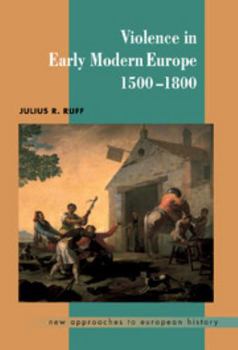Violence in Early Modern Europe 1500 1800
(Book #22 in the New Approaches to European History Series)
Select Format
Select Condition 
Book Overview
A broad-ranging survey of violence in western Europe from the Reformation to the French Revolution. Julius Ruff summarises a huge body of research and provides readers with a clear, accessible, and engaging introduction to the topic of violence in early modern Europe. His book, enriched with fascinating illustrations, underlines the fact that modern preoccupations with the problem of violence are not unique, and that late medieval and early modern European societies produced levels of violence that may have exceeded those in the most violent modern inner-city neighbourhoods. Julius Ruff examines the role of the emerging state in controlling violence; the roots and forms of the period's widespread interpersonal violence; violence and its impact on women; infanticide; and rioting. This book, in the successful textbook series New Approaches to European History, will be of great value to students of European history, criminal justice sciences, and anthropology.
Format:Hardcover
Language:English
ISBN:0521591198
ISBN13:9780521591195
Release Date:October 2001
Publisher:Cambridge University Press
Length:284 Pages
Weight:1.25 lbs.
Dimensions:0.9" x 6.1" x 9.1"
Customer Reviews
1 rating
The old good times were violent times.
Published by Thriftbooks.com User , 23 years ago
Perhaps History nowadays insists so much in reproducing the economical aspects of past societies that it becomes sometimes rather an abstract overview of life, as if everything depended on the play of the impersonal forces of supply and demand. In this case, the author provides us with a refreshing approach to a somewhat not enough studied phenomenon, that of violence, leading us to abandon the idyllic idea that ?any past time was better?. With this well documented book he reconstructs some of the least attractive aspects of our ancestors? life, i.e., those related to violence of common life. His goal is to asses the nature and extent of violence in early modern times in Western Europe (basically, England, France, Germany, Italy, the Low Countries, Scandinavia and Spain), to examine its causes and to weigh the reason for its generally decreasing incidence until the 20th century. The period covered (1500 to 1800) has been chosen because of two reasons: 1) to identify slow, but real evolution in the violence of Europeans, individually and collectively, over three centuries; and, 2) ?more important, however, our period encompasses an era of extraordinary changes in Western Europe. Social and economic historians have now come to understand that many of these changes had profound impacts on violent behavior and state responses to it, which we will gauge in this book ?. I have rated this book four starts. Considering its content, I think it should be five; considering its readability, three.






